Veteran players were free to begin their summer break Thursday afternoon after the Chicago Bears wrapped up minicamp at Halas Hall, setting them loose until they have to report for training camp July 19.
There’s palpable excitement for the team inside the building — and outside. In contrast to optimism at the end of the offseason program in recent years, this time it appears to be more rooted in reality. But as everyone from general manager Ryan Poles to middle linebacker Tremaine Edmunds has said, it’s all on paper at this point.
Roster improvements and staff upgrades don’t become real until the product on the field starts winning more consistently. Everyone involved understands that. It’s a bottom-line business and the Bears appear ready to compete in what should be a rugged NFC North.
Even if the Bears will not have a lot of true position battles this summer — not for starting jobs, anyway — questions loom for the organization. Some will be answered in training camp and preseason. Some will linger into the season.
Here are 10 to ponder as the Bears hit their break — the rookies will be free after three more OTAs Monday through Wednesday.
1. Caleb Williams
The development of the No. 1 pick will be the biggest storyline of the year, and the significance of his progress cannot be overstated. If Thursday’s minicamp finale is evidence — and be really careful putting a lot of stock in 11-on-11 drills when there are no pads, no pass rush, no press coverage — he was significantly more comfortable in the red zone than he was the first OTA drills.
Coach Matt Eberflus likes the idea of matching Williams and the first-team offense against the starting defense. A lot of times, coaches will have ones versus twos in practice.
“I don’t like that,” Eberflus said. “I think that Caleb is a talent. A very good talent. His game will go to where it needs to be. I want him to see that in front of him, the windows closing, the variation of what we do on defense, and I want him to see that day in and day out so that when he gets to play somebody else it will look, ‘OK, I’ve been there done that.’ That’s how we’re going to keep it.”
Williams seems comfortable in his role as the face of the franchise, certainly more at ease than Justin Fields and Mitch Trubisky were. That matters too. Breaking through what has been mostly an 80-year franchise problem at the position doesn’t seem daunting to Williams.
“It’s pretty awesome,” he said. “I feel like there’s a light at the end of that tunnel. Right now, we’re working with our head down and we’re building. Just having that moment with myself, I do it every day. I sit there and I say, ‘We’re going to be pretty damn good.’ So just got to keep working, keep going and we’re all excited. It’s really important to have that mindset but also have the mindset of, ‘Let’s keep going, let’s keep working, let’s get after it.’ ”
2. Offensive line
The Bears know they need to be better at protecting the quarterback, and even though Williams is athletic, he’s not expected to pull the ball down and run as much as Fields, whose production as a ball carrier propped up the team’s rushing statistics the last two seasons. So yes, the Bears will have to be better at run blocking as well.
Left tackle Braxton Jones missed the last two days of minicamp. It’s never a good thing when a lineman isn’t on the field during noncontact drills without pads, but the good news, according to two sources, is that Jones’ absence was unrelated to the neck injury that sidelined him for six games in the middle of last season and lingered even after he returned. Jones has a huge opportunity, especially after the team opted to select wide receiver Rome Odunze with the No. 9 pick instead of going for a left tackle candidate. Jones is entering his third season, and if he performs well he could position himself for extension talks next offseason.
Right guard Nate Davis was quite limited in the three days of minicamp, which meshes with his offseason last year and with his track record with the Tennessee Titans. The Bears are hopeful he can bounce back after a somewhat disappointing season, and the guaranteed money in his three-year, $30 million contract runs out this season. If Davis wants to complete the contract in 2025, he must play better.
Left guard Teven Jenkins, a second-round pick in 2021, is entering a contract year. Maybe he’ll stick with the Bears, but they’re wise to wait into the season to see how Jenkins, who has had a series of minor injuries, holds up.
Then there is the prospect of Ryan Bates stepping in as the starting center. The Bears tried to land him as a restricted free agent in 2022, and after trading for him, it’s readily apparent they hold him in high regard. He has played more guard but projects as the starting center. Can he rise above the level of being a stop-gap measure and be a true improvement?
None of these questions should overshadow the development of 2023 first-round pick Darnell Wright at right tackle. He was very good at times as a rookie but needs to be more consistent — week to week and even play to play — to emerge as the kind of foundational piece the Bears believe he can become.
3. How will all of the skill position talent work?
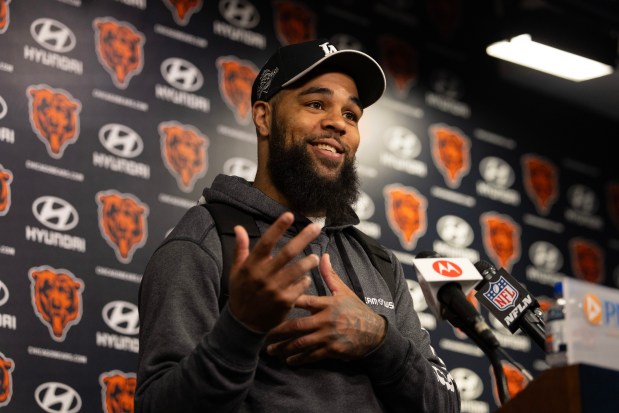
To be very clear, this falls under the category of a good problem to have with Keenan Allen and Odunze joining DJ Moore in the wide receiver room, Gerald Everett pairing with Cole Kmet at tight end and D’Andre Swift being signed at the outset of free agency as a running back with big-play ability.
Williams and offensive coordinator Shane Waldron will have no shortage of options, but there’s only one football to go around on game days, and it can be challenging. The receivers can have a race to 1,000 yards, and it projects as one of the better groups in the league. Bringing it all together cohesively is a challenge for Waldron and something that will give opposing defensive coordinators reason to have concern, especially when compared to most skill position groups the Bears have had over the last decade.
4. Pass rush
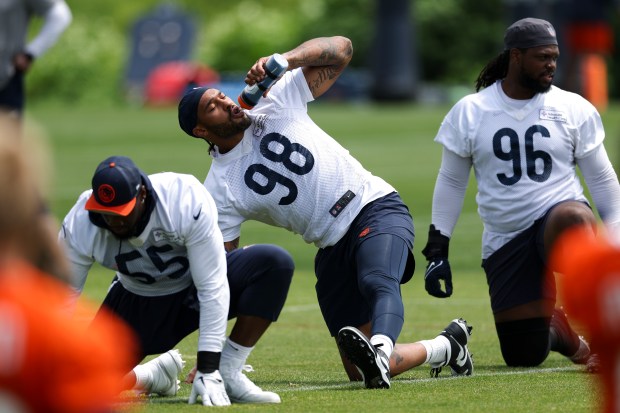
Even with a half-season of Montez Sweat, who led the team with 6½ sacks, the Bears still ranked 31st in sacks with only 30. The hope is it is much improved this season — defensive tackles Gervon Dexter and Zacch Pickens should be more prepared to contribute in their second seasons, and maybe rookie Austin Booker can create a niche in the rotation.
But the pass rush was underwhelming — and not for a lack of opportunities. Often times, teams playing with a lead in the second half of games can get more chances to hunt the quarterback. The rush defense was so good that Bears opponents attempted 617 passes, tied for the fourth-most in the league. Sweat won’t be able to do it all himself, but with a full season the Bears hope things are improved. It’s not all about sacks. Quarterback pressures and hits, anything to disrupt the opponent’s passing game, make a difference.
5. Gervon Dexter’s development
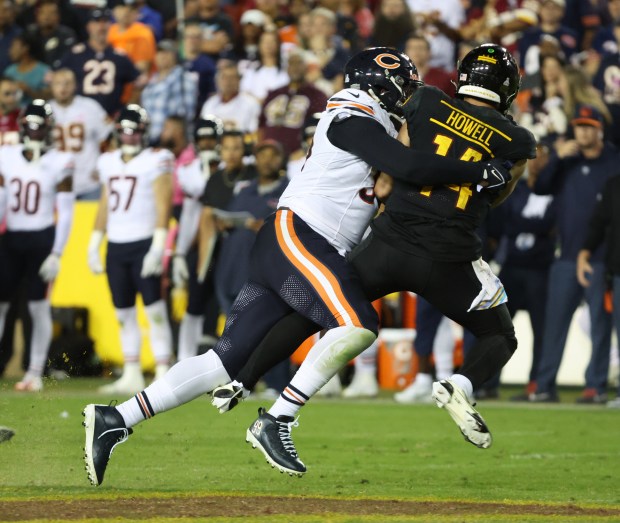
The departure of veteran Justin Jones has created a starting spot for Dexter as the three-technique tackle. He reshaped his 6-foot-6, 312-pound frame and looks leaner, and the results really struck the coaching staff after he had nine quarterback hits in a seven-game stretch in the second half of his rookie season. Dexter played in a read-and-react scheme at Florida, and the Bears want him to attack off the snap, something that was a stumbling block at times.
“That was one thing he had to work on and then pad level, because he’s such a big guy, tall guy,” Eberflus said. “And he’s worked on those things. But his movement, his athletic ability is even better now because he really worked on his body.”
A leaner and more explosive Dexter could lead to more production, and the Bears would really like to be more disruptive in the middle of the line.
6. Running back workload
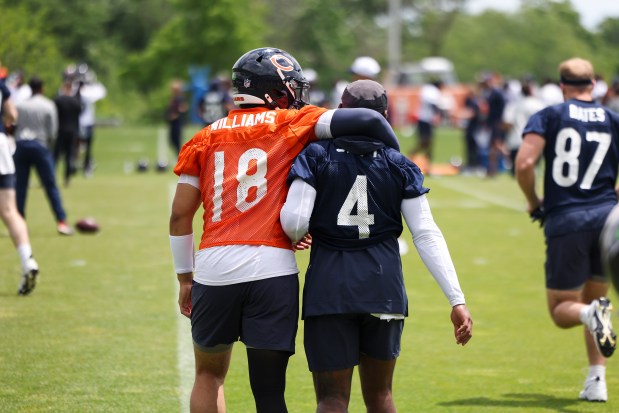
If Swift can be a more explosive producer — both as a runner and receiver — the offense will have a new element. After averaging 121 carries over the first three seasons of his career in Detroit, Swift had 229 attempts last season in Philadelphia. The Eagles didn’t involve him very much in the passing game, not as much as he was accustomed to with the Lions, and this should be an expanded part of his game as the Bears seek easy completions for Williams. Swift was targeted 148 times in 2021 and 2022 in Detroit and brings an element to that part of the game the Bears haven’t had since they were throwing the ball to Tarik Cohen.
It’s also worth wondering how Waldron will stack the running backs with Roschon Johnson and Khalil Herbert behind Swift. Will there be a role for fullback Khari Blasingame on the roster? It’s a question to dive into later in the summer.
7. Kevin Byard’s impact
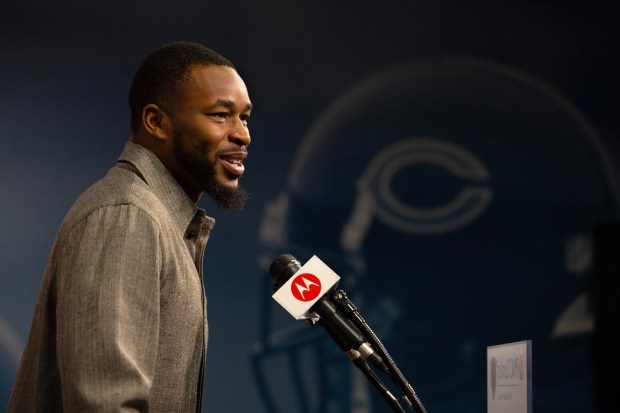
The team targeted Byard because they believe he can be a steadying influence for what still is a youthful secondary. The goal is to squeeze another productive year or two out of a veteran entering his ninth season. While the player he is replacing, Eddie Jackson, struggled with a string of injuries, Byard has been a model of durability. At some point, play begins to slip for every player who has been in the game as long as Byard. He might not be the impact guy he once was for the Tennessee Titans, but it’s clear the Bears holds him in regard.
“He’s special, just in terms of a leader,” Eberflus said. “People respect him just because of the man he is, and he’s been a devoted guy to this game for a long time. You can really feel that. That’s palpable. You can feel the love of the game that he has. He’s very respectful. He’s like a coach on the field. He’s got really good ball-hawking ability. That’s why I like him a lot.”
8. A payday for DJ Moore?
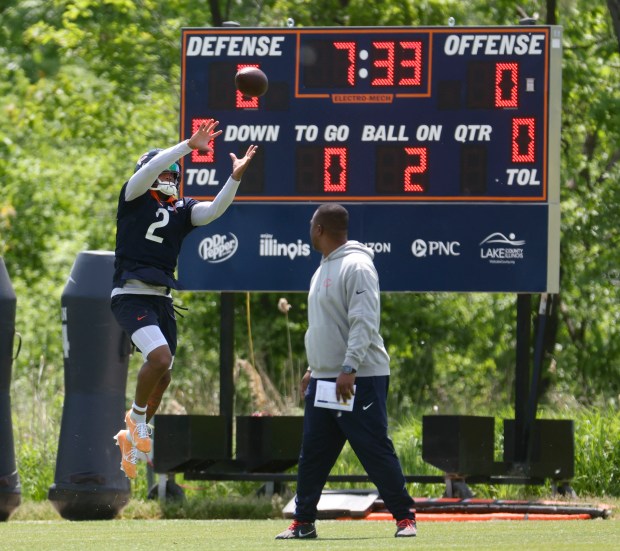
The Bears still need to knock out contracts for their top two draft picks — Williams and Odunze — and then the next order of business could be a pay raise for Moore. He’s signed through the 2025 season and is a bargain on the three-year, $61.88 million extension he signed with the Carolina Panthers in 2022. He’s due $16.05 million this season and next, which makes him underpaid in a receiver market that absolutely took off this offseason.
The topic has surely been broached by Moore and the team by this point, and there’s no rush to get a new deal done. File this away for late in training camp or perhaps early in the regular season, but Poles probably believes he needs to address Moore’s situation before considering any other contractual issues with veteran players.
9. Additions?

It’s worth wondering if the Bears will bring in a veteran before training camp. A pass rusher would be the most obvious addition. Jacob Martin caught Sweat’s eye on the practice field and has had some experience in the scheme playing in Houston under Lovie Smith. The Bears have to determine if Martin is a viable rotational player or if someone such as Yannick Ngakoue would be an upgrade. But they also have to answer the question as to whether Ngakoue would actually fill a void. He was underwhelming at $10 million last season and probably wouldn’t get much more than $3 million or $4 million from the Bears.
As much as Poles raved about Marcedes Lewis’ impact last season, the team could consider re-signing him. Lewis still a high-level blocker, and if the Bears opt to go without a fullback, perhaps there would be a role for him.
10. Eric Washington’s impact
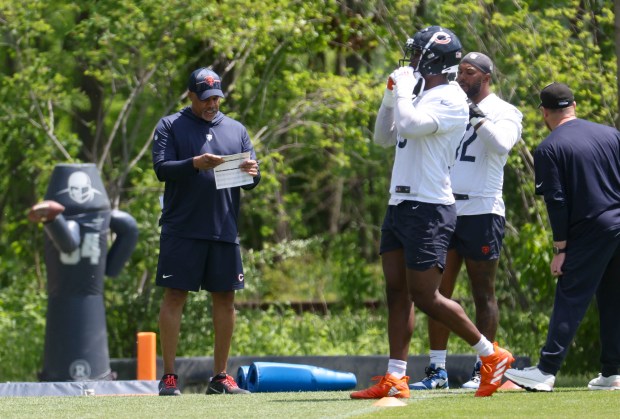
Eberflus plans to continue calling the defense, and there was a noticeable change after he took over for Alan Williams last season. Opposing teams mentioned that the Bears seemed to have a more defined game plan from week to week.
Washington’s backround is as a defensive line coach, and part of the thinking in bringing him in from the Buffalo Bills is that he helps take the defensive line and pass rush to the next level.



